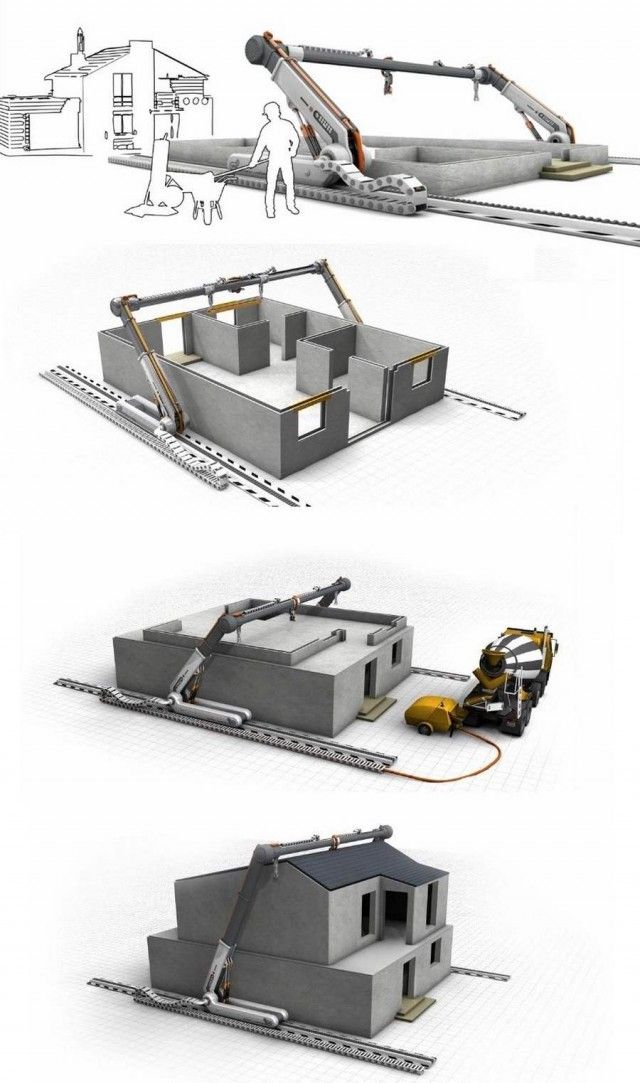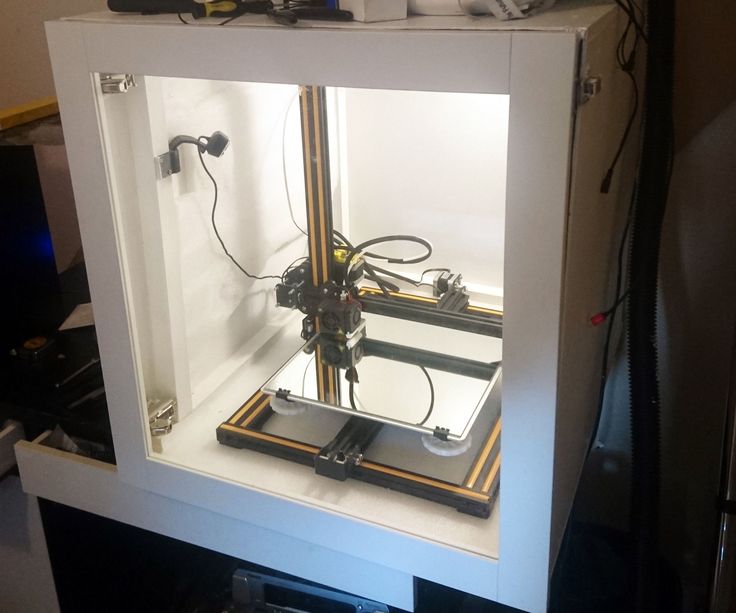Paper based 3d printer
How Paper-Based 3D Printing Works: The Technology and Advantages
Dear Desktop Engineering Reader:
Mcor Technologies and its paper-based 3D printing and prototyping systems have generated a good amount of buzz in the media. But who are these guys? Where did they come from? And what’s this paper-based model business all about anyway? Today’s Check it Out takes you to a PDF that answers those questions and provides additional food for thought. Assuming that you don’t get a letter with a check for a gazillion bucks for being a good person, this might be the most interesting thing you’re going to read all day.
“How Paper-Based 3D Printing Works: The Technology and Advantages” begins with an unexpectedly warm personal note on the company’s history. The short of it is that two brothers from Ireland got the 3D printing bug in the early days of the technology when it was so expensive only the select few could use it. They wanted develop a robust, eco- and user-friendly 3D printer with low operating costs and quick ROI (return on investment) so that 3D printing would be accessible to people in settings as diverse as engineering, manufacturing, entertainment and education. And from that vision began Mcor Technologies and its paper-based 3D printing technology.
Both monochrome and full-color 3D printers from Mcor leverage what is called SDL (selective deposition lamination) technology. SDL is an additive technology with a minor subtractive element. “How Paper-Based 3D Printing Works” gives you in-depth details on the process. But, basically, the process stacks, glues, heats, presses and cuts around patterns on sheets of standard letter-sized paper to build your model.
Post printing, you peel away – they call it weeding – and discard the excess paper in your office paper recycling bin. There’s no dunking parts in a chemical bath, vacuuming powder or things like that. If you want a part to be drilled, threaded, or water resistant, you can apply or dip it in a common finish.
The part you get is not origami delicate, although you can build fragile features. Resolution is 0.00047 in. (0.012 mm) and dimensional accuracy is 0.004 in. (0.1 mm), so you get good details. Parts are described as being hard and “essentially reconstituted wood.”
Parts are described as being hard and “essentially reconstituted wood.”
The paper provides a detailed explanation of the supplied Windows-based software you use to prep your part. This is what you’d expect here: You import a file in a standard format and position your model. The software takes care of slicing the model into printable layers and the rest of the tricky work. For color printing, you also use a second application to apply color to your 3D digital files.
The color printing process is interesting. The Mcor IRIS system can print more than one million colors simultaneously. Its color capability is 5760 x 1440 x 508 dpi. The water-based ink permeates the paper, which means a model’s undersides, overhangs and sidewalls are fully colored.
After explaining SDL technology, the discussion turns to costs. Here, Mcor makes the argument that its 3D printers are cost-effective and therefore accessible for all types of users, whether engineering, commercial or educational.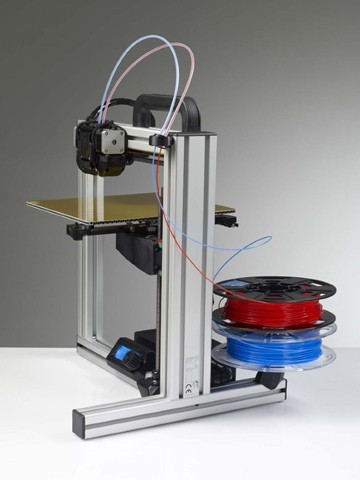 Mcor claims that its part costs are about 5% of those of other technologies. That, in turn, projects to a five-year ROI one-fifth that of other 3D print technologies.
Mcor claims that its part costs are about 5% of those of other technologies. That, in turn, projects to a five-year ROI one-fifth that of other 3D print technologies.
Materials are key. You don’t need specialized plastics, powders or infiltrants. Literally, you can go to your local office supply store and buy paper, and you can even reuse paper from your office. The company backs up these claims with an image gallery of objects created with its units. Each image provides the actual component size and its production cost in both dollars and euros. The image of a 3D printed orange for less than three bucks is incredible.
“How Paper-Based 3D Printing Works: The Technology and Advantages” runs 10 pages. If you had been wondering about SDL paper-based 3D printing systems from Mcor Technologies and what could possibly be in it for you, this is as definitive account as you’re going to find. Hit today’s Check it Out link and download a complimentary copy to see for yourself.
Thanks, Pal. – Lockwood
– Lockwood
Anthony J. Lockwood
Editor at Large, Desktop Engineering
Download “How Paper-Based 3D Printing Works: The Technology and Advantages” here.
Paper-based 3D printing is manufacturing's big new idea
Fans of the movie Close Encounters of the Third Kind will remember a scene in which Richard Dreyfus sculpts a scale model of the ‘alien’ mountain in his living room. He’s the very picture of the driven obsessive. He just doesn’t have any choice.
Conor MacCormack (pictured right) would sympathise. His living room housed a prototype 3D printer for months in 2004.
The CEO of Ireland’s Mcor Technologies never saw himself as an inventor, still less an entrepreneur. Until 2004, he’d been happily working as an engineer. But then he began working with nascent 3D printing technology.
Like everyone else, he was fascinated with its potential, but also frustrated at the huge cost of the machines and – more so – the plastic ‘consumables’.
Traditional 3D printers use plastics, which is the only material that can be melted, and then quickly hardened but which doesn’t require a tremendous amount of heat.
That frustration led to an epiphany. Why not use paper?
MacCormack, and his engineer brother Fintan, became obsessed with the concept.
“People thought 3D printing was like something out of Star Trek at the time,” he says. “There was such enthusiasm for the idea. But we always felt the big problem was the running cost.
“The big three players in the market price were using plastics that were very expensive. We began to wonder if there was a way to make a machine such that users would never worry about the cost of parts.”
The glue issue
Paper based 3D printing seemed the obvious solution. The problem was the glue. MacCormack’s prototype required a water-based adhesive rather than the solvent used by the incumbent machine makers.
But water-based glue is very viscious (1500 times thicker than water) and and cannot be jetted out with conventional print heads.
The brothers had to develop new kind of printer that jets it out in controlled way.
The result filled Conor’s living room.
In 2004, the MacCormacks decided to turn their tinkering into a business. They’d been showing their paper-based 3D printing ideas to enterprises and universities and the response was overwhelming.
“There was huge interest in 3D printing, but hardly anyone could afford to buy and run a machine. Everyone we visited said: ‘if you could build your machine, we’d buy it’.”
Overnight sensation
So Mcor was born, funded by bank loans during the pre-crash years in Ireland when banks still had money.
The big break came in 2010, when Mcor’s CMO Deirdre MacCormack (Conor’s wife) wrote an article about paper-based 3D printing and circulated it to the trade press.
Cue global interest: 1800 enquiries and two million website hits in ten days.
Mcor was on the radar, and though it still didn’t have a commercial paper based 3D printing machine, it now had access to finance. Angels put money in, and this was matched by Enterprise Ireland. The first production machines were made in 2010.
Angels put money in, and this was matched by Enterprise Ireland. The first production machines were made in 2010.
The devices use ordinary business paper. When the paper is bonded together, the resulting 3D printed model is tough and durable. It looks and feels like wood.
And when the end result is treated, the object is waterproof and extremely strong. In fact, Mcor has printed working hammers and bottle openers.
But for all the success of its technology in 2010, Mcor still had a problem. How to get these machines to market? The three giants of 3D printing – Z Corp, 3D Systems and Stratasys – controlled the dealer network.
MacCormack says: “We didn’t have resellers. They didn’t want to jeopardise their relationships. So we had to find new dealers from scratch. It took 18 months to get to 60 and without local dealers, we had to fly out engineers ourselves when a machine broke down. It was very tough.”
However, momentum was on Mcor’s side. Its two machines were retailing for a similar price to its competitors ($50,000 for the full color model) but cost up to 20 times less to run.
Off to the Valley
To maintain growth, the founders embarked on a fresh round of funding, pitching to virtually every major VC in the valley. MacCormack remembers it all as exhausting and exhilarating.
“Nearly everyone we saw was very enthusiastic. And it was great for us to go through that rigorous questioning and due diligence. By the end of the process we felt like a new company.”
The positivity was a little surprising given that VCs generally invest in software, and prefer companies with recurrent revenue rather than unit sales.
MacCormack says: “I realise that recurrent component sales can be lucrative and also measurable in terms of forward projections. But we believe we can get massive demand for our paper based 3D printing machines. And most of the investors were pretty responsive.”
Most, but not all.
“One VC held up a phone and said ‘if it’s not an app, I’m not interested’, and walked out of the room.”
When the founders met investment firm WHEB, they knew they had their partner. “They just got it. We didn’t have to explain the market or spend long on paper based 3D printing tech,” says MacCormack.
“They just got it. We didn’t have to explain the market or spend long on paper based 3D printing tech,” says MacCormack.
WHEB led a $12m round in 2014. But the deal was about more than money. WHEB is a specialist in sustainable, resource-efficient and energy-efficient ideas. It therefore has contacts and know-how. It also helps that it’s based in London.
This time, it’s personnel
Meanwhile Mcor’s business powers on. In 2014, it reported a 308 per cent rise in sales, and 69 per cent growth in employee numbers.
The latter included key additions such as the hire of Graham Lindsay (sales manager for EMEA) and Bryan Ferrand (VP of global sales and services). Both had previously worked at Z Corporation.
In November, Mcor scored its biggest coup by appointing former Z Corporation CEO Tom Clay to its board of directors.
The future is looking good for the firm. It’s selling many hundreds of paper based 3D printing machines a year to enterprises in education, industrial design, architecture, medical and dental.
It’s even saved businesses. Pattos Place of Sydney Australia – a model car maker – was going under because of the cost of plastic 3D printing. Switching to paper reduced the cost of a set of four moulds by more than $180.
The saving enabled Pattos Place to keep trading.
But further ahead, Mcor is confident that 3D printing will move beyond being a tool to make prototypes to becoming something transformational.
Selfie conscious
The appetite is there. That much was apparent when Mcor won the Best of CES 2015 Award in the category of 3D Printers in January. The firm made headlines and drew crowds probably because of its ability to print 3D selfies.
A gimmick? Maybe. But perhaps the start of something.
MacCormack says: “The market is still looking for its killer app, really. There’s definitely snobbery in the industry – the feeling that you should only print parts for Boeing and so on.
“But I think the idea of scanning yourself from a phone app or whatever will be first step of penetration into the consumer market. And that market will be huge.
And that market will be huge.
“The idea that you can get a new part for something you want in an hour? That’s probably five years away.”
Ultimately, MacCormack believes the most profound impact of 3D printing will be the ability to make things quick and fail fast. This will encourage anyone with a product idea to act on it.
He says: “All the best innovation comes from seeing a way to make a product better than the norm. In the past that has taken huge determination and many years. If we can build prototypes in days, the impact on society could be huge.”
Paper 3D printer AKNT i3
Paper 3 d printer AKNT i3
The work on the Paper 3d printer was started at the amateur radio circle of the Almaty State College of New Technologies (hereinafter AKNT College) after reading the article “3d printer for $ 60” . After reading the article, it was decided to start work, especially since several of the necessary stepper motors, Arduino Mega were already available. While studying the topic of making 3d printers, there was a desire to make the printer more serious, with a larger print area. Such a printer was needed for our robotics circle, for the manufacture of various parts for projects. Of course, there were no funds to purchase a new printer, even a ready-made kit. Therefore, college students and I tried to make our own printer and meet $60 (in the future, expenses will be calculated in dollars). It was decided to order only an extruder (printer print head), a bowden (filament feeder), two meters of belt, two rollers, a set of linear bearings, a Ramps 1.4 board with drivers and a display, a heating table from Aliexpress (cost $ 50). And the rest of the parts for the printer were selected separately.
While studying the topic of making 3d printers, there was a desire to make the printer more serious, with a larger print area. Such a printer was needed for our robotics circle, for the manufacture of various parts for projects. Of course, there were no funds to purchase a new printer, even a ready-made kit. Therefore, college students and I tried to make our own printer and meet $60 (in the future, expenses will be calculated in dollars). It was decided to order only an extruder (printer print head), a bowden (filament feeder), two meters of belt, two rollers, a set of linear bearings, a Ramps 1.4 board with drivers and a display, a heating table from Aliexpress (cost $ 50). And the rest of the parts for the printer were selected separately.
1Details of a 3d printer from Aliexpress
Almost all Mendel, Prusa i3 projects available on the Internet required to have another 3d printer for printing body parts, or order them from third-party organizations specializing in printing 3d models, which required another $ 30-50 ( in Almaty, an hour of printing costs about $5). Therefore, having gone through all the possible options, we decided to implement the RepRap technology, that is, to create a 3d printer from cheap materials, which in the future will be able to print the necessary body parts for itself (its upgrade).
Therefore, having gone through all the possible options, we decided to implement the RepRap technology, that is, to create a 3d printer from cheap materials, which in the future will be able to print the necessary body parts for itself (its upgrade).
On the GrabCad website, a design for a 3d printer body was found that does not require printing of parts. Having finalized this project in the AutoCad program, according to the thickness of the existing material - a piece of MDF (pressed paper) and made the necessary changes to some details of the drawing, all the developments were sent to an advertising agency (the cut cost $ 10). A week later, we received a lot of paper parts, which we adjusted with the guys for a few more days. The result of this work was the "paper" frame of the printer (Fig. 3)
Also in the college there were two unused inkjet printers and two scanners - sources of guides, however, as a result of disassembly, 3 guides for 8mm and 1 guide with a diameter of 7mm were obtained, which found their use in the Z and X axes.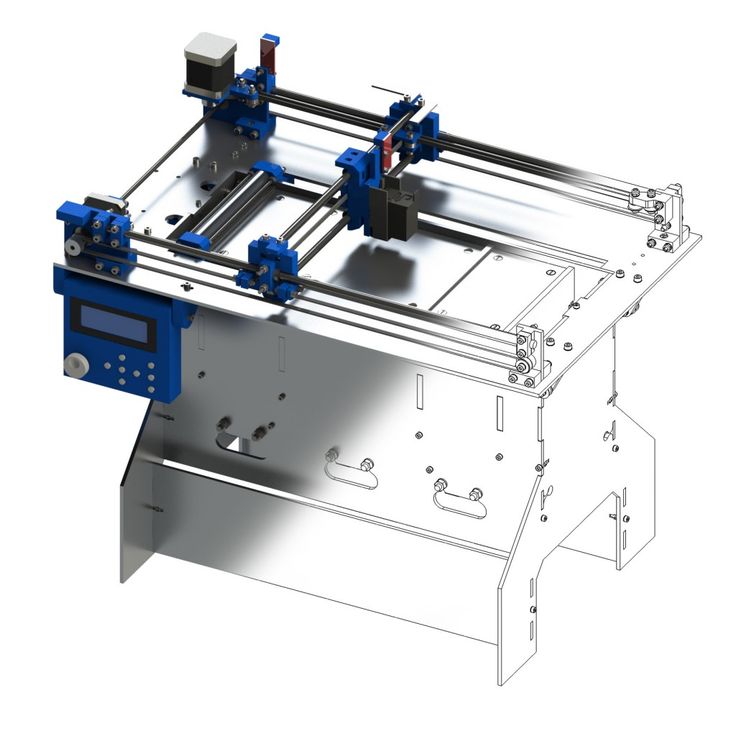 decided to use ball bearing furniture rails (courtesy of the college furniture shop). Stepper motors were originally planned to be used from printers and scanners, but they were different and there was a problem of fastening the rollers. In this regard, it was decided to investigate all the faulty equipment available in the college and the motors were found in the DMX lighting fixtures.
decided to use ball bearing furniture rails (courtesy of the college furniture shop). Stepper motors were originally planned to be used from printers and scanners, but they were different and there was a problem of fastening the rollers. In this regard, it was decided to investigate all the faulty equipment available in the college and the motors were found in the DMX lighting fixtures.
Two 8mm guides from printers were mounted on the Z axis, and guides from scanners were mounted on the X axis to mount the extruder. The 7 mm guide (due to the smaller diameter) was fixed with fluoroplastic bushings. The standard LM8MM bearings used in budget printers were lost in the vastness of vast China, and in order not to waste time waiting for a second shipment, the extruder mount was made from two scanning heads of scanners, the bearings of which are copper bushings pressed into the plastic body of the head. Having cut out fasteners with copper bushings from each scanning head, they installed them on the corresponding X-rails and glued them together. The result is a fairly strong extruder mount with good sliding along the X axis.
The result is a fairly strong extruder mount with good sliding along the X axis.
The package with the aluminum filament feeder and the E3D extruder was one of the first to arrive, so by the time of assembly it was already ready. It was decided to abandon the Teflon (PTFE) tube that comes with the extruder and connect the extruder to the filament feeder directly through an adapter machined in the college's turning shop. The result is the following satisfactory construction.
Since the belts and rollers were lost along with the bearings and were re-ordered, belts from scanners were found in the printer, which use a belt with a 2mm pitch, similar to GT2, only thinner and a little short for the X axis. Therefore, instead of a standard bypass bearing, a bypass roller with a metal mount from the scanner is installed.
M6 threaded stud, 80 mm long, found in the furniture shop of the college. Initially, furniture ties with M6 internal thread, drilled with a 5 mm drill for the motor rod, were used as couplings for studs with a stepper motor. Despite the imbalance due to these sleeves, sleeves made of PLA plastic were later printed.
Despite the imbalance due to these sleeves, sleeves made of PLA plastic were later printed.
Initially, the heating table was planned to be installed on the 3-way furniture rails available, but open access to the bearing balls did not inspire confidence, so it was decided to turn the rails over, fix the table to its main part (base), and fix the middle part to body of the 3d printer using steel corners, the third part of the guide is removed along with the balls. The main disadvantage of such guides is the sound, it can be assessed by ear when the table is moved quickly - unpleasant squeaks of the movement of the balls were emitted. In this connection, when linear bearings appeared, “handicraft” guides were replaced with classic ones used in all ready-made 3d printers.
As end sensors, we chose a circuit based on optical sensors soldered on breadboards. The diagram and photographs are shown in the figures below. On the Z axis, the distance between the table and the print head was calibrated by screwing in the adjusting screw. Along the Y axis, the sensor is mounted on an aluminum corner and fixed to the rear wall.
Along the Y axis, the sensor is mounted on an aluminum corner and fixed to the rear wall.
9
In the process of creating a printer, one of the biggest difficulties was to achieve high-quality printing from the print head (extruder), there were constantly plugs in the filament supply and marriage turned out. The ordered E3D V6 extruder kit turned out to be of poor quality. The steel thermal barrier does not have a Teflon sleeve, the fan and the radiator did not provide proper cooling. As a result, it was not possible to get even a fully printed test part, the thread became thinner or simply stopped feeding. Attempts were made to create their own thermal barrier from a drilled M6 bolt and an inserted piece of Teflon tube, which was installed in the radiator from the amplifier or in the aluminum supply block of the supply part.
In the end, a high-quality E3D V5 extruder kit was purchased at the Karaganda RadioMart store for $ 14. After installation, all printing problems were resolved. In the Compass 3d program, an extruder mounting model was developed, which was printed using a high-quality thermal barrier. Therefore, advice to beginners - choose an extruder with a terbobarrier with a Teflon insert, or order a spare thermal barrier from the seller, my savings of $ 5-7 resulted in a loss of a large amount of time and a bad mood. The 3d model of the extruder mount and its appearance are shown in the figures.
In the Compass 3d program, an extruder mounting model was developed, which was printed using a high-quality thermal barrier. Therefore, advice to beginners - choose an extruder with a terbobarrier with a Teflon insert, or order a spare thermal barrier from the seller, my savings of $ 5-7 resulted in a loss of a large amount of time and a bad mood. The 3d model of the extruder mount and its appearance are shown in the figures.
As soon as the 3d printer started printing, significant shortcomings of the inexpensive paper construction (MDF) were revealed - the layers did not overlap evenly due to the insufficiently elastic construction, frame twitches were felt during printing, etc. Therefore, they began to refine and strengthen the entire structure. Firstly, all the details of the X axis were printed with PLA plastic. The belts from the scanners have been replaced with a GT2 belt, bypass bearings have been installed. Furniture guides were dismantled and replaced with guides with linear bearings. A massive base for the printer was cut out of a piece of table top 28mm thick (molds). Two 7mm guides were replaced with 8mm ones found in car torsion bars (trunk shock absorber from an AUDI A6 station wagon).
A massive base for the printer was cut out of a piece of table top 28mm thick (molds). Two 7mm guides were replaced with 8mm ones found in car torsion bars (trunk shock absorber from an AUDI A6 station wagon).
U-shaped housing frame reinforced with aluminum corner. To give a stylish look, all paper parts are painted with blue and black paint. The standard 30mm extruder fan was replaced with a more efficient 40mm, which also required a new mount to be printed out. An impeller was used to blow the parts instead of the usual, originally used fan.
The printer was assembled in the college's electronics lab with the active participation of two students.
Below are photos of the first and last versions of our 3D printer. Work on improving the printer continues and, most likely, will continue for a long time. The printer will serve our robotics club well, especially since the school year is already in full swing.
Finally, we can conclude that RepRap technology really works, that is, a printer that can reproduce most of its own parts. The first option is almost completely made of pressed paper - MDF boards; guides, belts, rollers, bearings, sensors and even motors were found from old technology, or made from improvised materials. When the printer was launched, all the main parts were printed on it, which made it possible to significantly improve the quality of printing. Total amount spent,
The first option is almost completely made of pressed paper - MDF boards; guides, belts, rollers, bearings, sensors and even motors were found from old technology, or made from improvised materials. When the printer was launched, all the main parts were printed on it, which made it possible to significantly improve the quality of printing. Total amount spent,
taking into account the consumption of filament, paint, etc. – 90$.
90,000 laser 3D metal printer, industrial 3D printers of a new generation, overview of a printer printingJewelry
Medicine
3D printers
Science and education
Author: Semen Poladeyuk
Author: Semen Potayk
Top 7 Benefits of Sharebot MetalONE | Applications and Consumables | How MetalONE was created | Key Features of the 3D Printer
Metal 3D printing is the most complex of additive technologies, but the path to it may be easier than you think. Freedom of design, the ability to optimize the design, reduce the weight of the product and the number of elements in the assembly, the use of materials with unique properties - all these advantages of the technology are invaluable for experimental and research work, the ultimate goal of which is to quickly and efficiently create new high-tech products (or upgrade existing ones), taking production capabilities to the next level.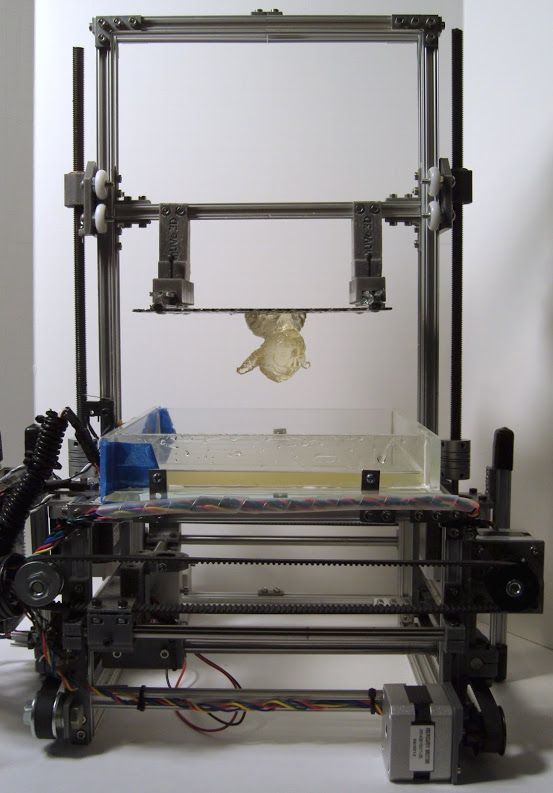
The integration of metal 3D printers into the production process is associated with considerable difficulties. A metal printer is an installation that requires a large investment, a special facility, strict operating conditions, additional equipment, and a highly skilled operator.
However, recent trends suggest that metal printing can become, as they say, “closer to the people”. When we visited the largest Formnext exhibition in Frankfurt am Main in 2019, we noted the appearance of compact metal 3D printers. These machines have a simplified functionality and are focused primarily on the scientific and educational sphere and small and medium-sized businesses.
One of the most attractive installations in this category in terms of price and quality is called MetalONE and is based on the direct metal laser sintering (DMLS) method. This is a new product of the Italian company Sharebot, which has a solid experience in the development of several 3D printing technologies. The printer is designed for research, product testing and manufacturing of small and medium-sized parts.
The printer is designed for research, product testing and manufacturing of small and medium-sized parts.
Can 3D printing help you optimize production in your organization? Book a consultation with iQB Technologies experts. Services such as 3D training, test 3D printing/3D scanning, site visits, diagnostics or ordering 3D equipment are also available.
MetalONE Metal 3D Printer: Top 7 Benefits of
- Compact working chamber (65 x 65 x 100 mm).
- High performance.
- Economy.
- Possibility of using argon and nitrogen.
- Intuitive, easy to edit print options.
- Easy to operate.
- Low maintenance.
Applications and Consumables
This metal 3D printer will be indispensable in the following industries:
- R&D;
- industry;
- dentistry;
- jewelry.

Sharebot CEO Arturo Donghi with MetalONE 3D printer and printed samples
The additive setup is ideal for exploring new materials, and thanks to its small build chamber and DMLS technology, it allows you to create objects from a small amount of metal powder - only 800 g. In addition, the user can edit all process parameters, which will be recorded in a log after printing is completed. With a 250W fiber laser and the ability to use both nitrogen and argon, virtually any powder can be tested.
For industrial applications, the printer is capable of prototyping small parts with incredible precision and producing them quickly and without significant difficulty. Unrivaled print repeatability ensures low-volume production with consistently high quality.
Cobalt-chromium alloys (CoCrMo), which are widely used in dentistry, are also applicable in MetalONE. For dental laboratories, this is a real boon: the 3D printer prints metal fillings, crowns and caps in less than an hour and is exceptionally easy to use.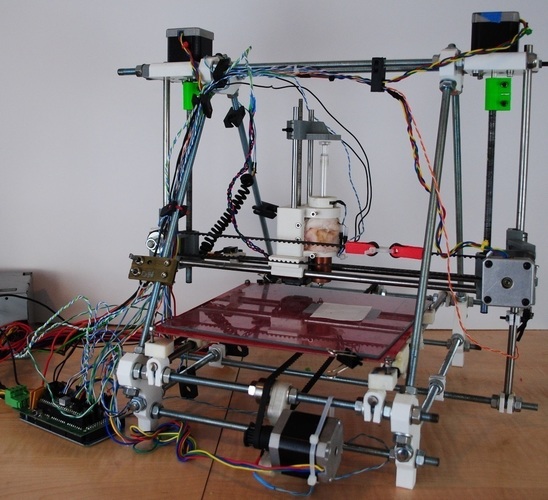
Due to the compactness and special structure of paper filters, the printer will also be beneficial in the additive manufacturing of jewelry and other miniature products, as it allows you to quickly create objects with the highest degree of detail.
Sharebot's R&D department, in collaboration with several universities, has developed profiles for 316L steel and cobalt-chromium and continues to test new powders for metal laser 3D printer. Next in line are profiles for titanium and aluminum.
How MetalONE
was created Work on the metal printer project began in 2015. At the same time, Sharebot was developing SnowWhite, a machine for printing with thermoplastic powder using SLS technology. After the successful implementation of SnowWhite in different countries, Sharebot gained enough experience to launch a metal 3D laser printer project. It includes other types of powders, software, mechanical components, and build chamber design (involving the creation and maintenance of a modified environment), but this machine can be considered a direct continuation of SnowWhite.
It includes other types of powders, software, mechanical components, and build chamber design (involving the creation and maintenance of a modified environment), but this machine can be considered a direct continuation of SnowWhite.
In March 2019, the first prototype of the machine and the first samples were presented at the MECSPE exhibition in Parma. In the following months, various models were printed to test the metallurgical properties of the objects and their quality, as well as the reliability of the printer itself and the repeatability of printing. All parameters of the printing process are available to the user, allowing you to explore and explore new materials and applications.
So, Sharebot MetalONE will be a profitable solution if you need to research and test complex small-sized products, material properties, and also produce small series.
Key Features of
3D Printer- Build chamber: 65 x 65 x 100 mm
- Layer thickness: 5-200 microns
- Laser: fiber, 250 W (1080 nm)
- Spot diameter: 40 microns
- Maximum speed: 5 m/s
- Software: Simplify 3D - Continuum
- Printer dimensions / weight: 740 x 630 x 1000 mm / 170 kg
MetalONE is available for order on sharebot.


